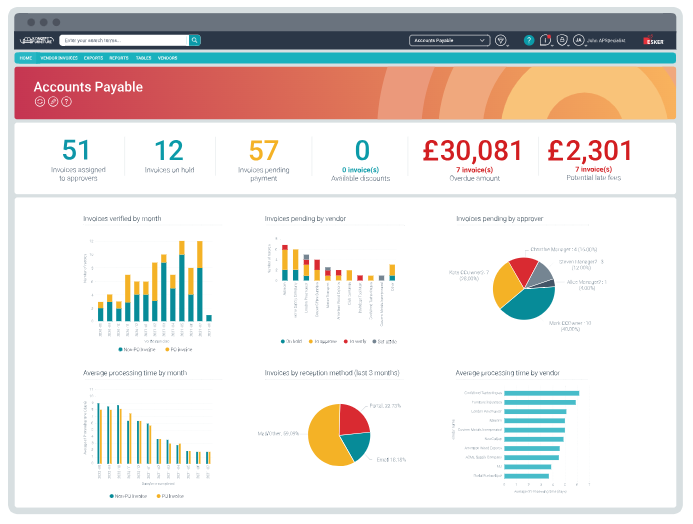Title
10 Key KPIs to Fall in Love with Your Accounts Payable Process
Efficient Accounts Payable (AP) management is vital for business success, yet many organisations face challenges like high invoice processing costs and delayed payments. This blog outlines critical metrics and strategies to help businesses streamline operations and enhance performance. Below, we dive into these KPIs and their role in optimising your AP process.

Why KPIs Matter in AP
Key Performance Indicators (KPIs) provide actionable insights into your AP process, helping you identify bottlenecks, measure efficiency, and improve cash flow. By leveraging the right metrics, businesses can enhance supplier relationships, reduce costs, and achieve greater financial visibility.
The 10 Essential AP KPIs You Should Love Using
1. Cost To Process a Single Invoice - In a time where cash is more important than ever, AP departments need to know what they’re paying to process each invoice and have a strategy in place to mitigate costs. The total cost to process one invoice can be tricky to pinpoint. To get an accurate assessment, consider every expense involved in AP processing, including: costs associated with routing, copying and follow-up, staff salaries, managerial overheads, and IT support.
2. Time to Process a Single Invoice - There’s a reason people say time is money. In order to maximise AP’s profit-generating potential, companies must identify what’s slowing their process down and how to fix it. The time it takes to process a single invoice is a good KPI for determining how much value an AP department is either wasting or adding on a regular basis. The longer the processing time, the more likely it is you’re losing money on things like missed vendor discounts, late-payment fees, low staff productivity, vendor dissatisfaction.
3. Invoices Processed Per Day Per Full-Time Equivalent - Measuring staff productivity is a way to optimise AP invoicing even further, as what you learn from this KPI can be used to improve multiple areas of your operation. It helps to see where and with whom invoices are spending the most time. Not only does measuring this KPI provide a clear record of how many invoices are coming in per day and employee activity, it can also help you pinpoint which suppliers are causing staff the most problems.
4. Invoices Linked to a Purchase Order - If it impacts processing time and cost, you better believe it’s worth tracking. Smart AP departments use this KPI to gauge how seamless their processes really are and see where improvement is needed. Invoice validation is a key step in the approval process, so it makes sense that delays — like those caused by information not matching the PO — would be great concern to the AP team. In general, the lower your percentage of invoices linked to a PO, the slower, more expensive your AP process will be.
5. Invoice Exception Rate - Invoice exceptions are the bane of existence for AP clerks. Accounts payable staff spends a staggering amount of time managing and correcting invoice exceptions. To maintain process efficiency, AP departments should track and continually review this KPI. Considering the regularity of exceptions, it’s easy to see why they pose such a problem. The amount of time and resources required to resolve them is a big reason why AP departments underperform. More often than not, exceptions are caused by discrepancies in PO and invoice data, missing/incorrect PO and bottlenecks in approval workflow.
6. Straight-Through Invoice Processing - With no manual intervention needed, straight-through or “touchless” processing is significantly cheaper and faster than manual methods. Measuring and improving this KPI is key to maximising margins and efficiency. Invoices that are automatically processed without any human intervention take only a fraction of the time as ones that have to be processed manually. Organisations with high levels of straight-through processing benefit from lower costs, more time for value-added activities, greater security, increased business efficiency and supplier satisfaction.
7. Suppliers That Submit Invoices Electronically - Getting suppliers to submit invoices electronically is the best way to speed up processing and make it easier for other companies to do business with you. There are two parties included in this metric: your company and your suppliers. Providing a way for suppliers to submit invoices electronically is only half of the equation. The other half is actually getting them to use your technology. The ability to onboard suppliers quickly and easily plays a big role in increasing electronic invoices submitted.
8. Early Payment Discounts Captured - It’s a win-win situation that lets you pay less for paying faster, and a KPI you should be tracking and capitalising on. Now more than ever, businesses are doing whatever they can to optimise cashflow. Early payment discounts allow you to keep your money in your company’s pocket, while also benefitting your suppliers’ bottom lines — helping to build stronger, longer-lasting supplier relationships.
9. On-Time Payments - If you can’t pay early, paying on time is the next best thing you can do to avoid paying late fees and straining relationships with suppliers. The health of your bottom line is what’s at stake with this one. A low rate of on-time payment is usually associated with highly manual AP processes that require more time and resources. Additionally, vendors are happier to do business with organisations that they trust to pay on time, every time.
10. Days Payable Outstanding - While more strategic and complex to calculate, DPO is one of the few KPIs that can demonstrate AP’s value beyond invoice processing and help justify department costs. Unlike the other metrics mentioned, DPO is much more subjective and ultimately dependent on cashflow strategy. DPO is the efficiency ratio for how long it takes a company to pay its suppliers, and it can pack a major punch when it comes to working capital. It can also be the determining factor between suppliers considering your company a “good client” or a “bad client”.

The Role of Automation in AP
By implementing automation tools like Esker Accounts Payable, businesses can transition from manual, paper-based processes to a streamlined digital workflow.
Experience:
- A Multi-channel platform - Esker offers a single, collaborative and cloud-based platform that promotes invoice visibility and reception channels, including EDI.
- AI-driven data recognition - Esker’s Artificial Intelligence (AI) Engine can manage and analyse all invoice data
- Customisation dashboards - Esker’s solution is equipped with intelligent dashboards that display live, visual analytics for fully customisable data tracking.
- Esker Anywhere™ mobile app - Enables managers to review and approve supplier invoices and track KPIs while on the go directly from their Apple or Android devices.
- Supplier self-service portal - a convenient online portal gives suppliers self-service access to payment information, helping them get paid quicker and reduce costs, and save your company time and money previously allocated to responding invoice status calls.
- Payment - Esker Pay is a robust payment solution that helps users better manage cashflow by eliminating complex and inefficient AR and AP processes.
- Supplier Management - Esker’s Supplier Management solution helps manage supplier information and automate processes across the supply chain
Benefits include:
- Lower Costs: Reduced manual labour and paper usage.
- Faster Processing: Accelerated approvals and payments.
- Improved Accuracy: Minimised errors through data validation and intelligent automation.
- Better Compliance: Digital records ensure transparency and audit readiness.
- Improved Relationships - No more dissatisfied suppliers & AP staff
Achieving AP Excellence
Tracking and improving these KPIs isn’t just about efficiency; it’s about driving strategic value. A well-optimised AP process can support better cash flow management, supplier relationships, and overall financial health.
Transforming your AP process starts with understanding where you stand today. By monitoring these ten KPIs and leveraging automation, businesses can unlock significant efficiency gains and love their AP processes. I’m a specialist in Esker’s Source-to-Pay solutions, including Esker Accounts Payable. Contact me today to request a demo, or to learn more about how Esker’s intuitive, AI-driven Accounts Payable solution can help your organisation to take control of your entire AP process.
